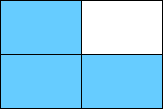Introduce this concept by using concrete examples. Begin addition and subtraction of fractions by using a manipulative such as paper fraction kits. Concrete examples allow students to comprehend the concepts.
| Materials | paper fraction kits made from colored construction paper. | ||||
| Preparation | Allow each student or pair of students to have a fraction kit consisting of the following: | ||||
| whole | white paper | eighths | yellow paper | ||
| halves | red paper | sixteenths | green paper | ||
| fourths | blue paper | ||||
| It is important that each student have the same color pieces. This will result in less confusion when you give instructions to the class. If you like, have students make their own kits. | |||||
| Prerequisite Skills and Concepts: | Students should have a basic knowledge of equivalent factions as well as comparing and ordering fractions. | ||||
| Ask: How many red pieces of paper does it take to completely cover your white piece of paper? | Students should identify that two red pieces will cover the whole white piece of paper | ||||
| What does one red piece of paper represent in relation to the white piece? Why? | Students should be able to identify that a red piece is one half because it represents one of two equal pieces that covers the whole. | ||||
| Ask: How many blue pieces of paper does it take to completely cover your white piece of paper? | Students should identify that four blue pieces will cover the whole white. | ||||
| Ask: What does one blue piece of paper represent in relation to the white piece? Why? | Students should be able to identify that a blue piece is one fourth because it represents one of four equal pieces that covers the whole. | ||||
| Ask: If one blue piece of paper is one fourth of the whole, what are two blue pieces of paper? How do you know? | If one blue piece of paper is one fourth, then two blue pieces are two fourths of the whole. Some students may say that two blue pieces also represents one half of the whole. This is true, but try to keep them focused on fourths. | ||||

|
The sum of one blue piece and two blue pieces is obviously three blue pieces. By using the fraction kit, students are encouraged to place the three blue pieces on the white whole. The picture shown below displays |
||||
| Continue with several additional addition examples using eighths and sixteenths. | |||||
| Ask: What does one yellow piece represent compared to the white piece? One yellow piece represents one eighth because eight yellow pieces completely cover the whole. |
Say: Cover your white piece with seven yellows. | ||||
| Ask: What fraction of the white piece of paper is covered? Seven-eighths is covered since yellows represent eighths and there are seven yellows. |
Ask: If you take away four yellow pieces, how many yellows will be left? What fraction of the white piece of paper will be covered? How do you know? If there are seven yellow pieces and you take away four, you are left with three. Three yellow pieces represent three eighths. Since one yellow represents one eighth of the white, then three yellows must represent three eighths of the white whole. |
||||